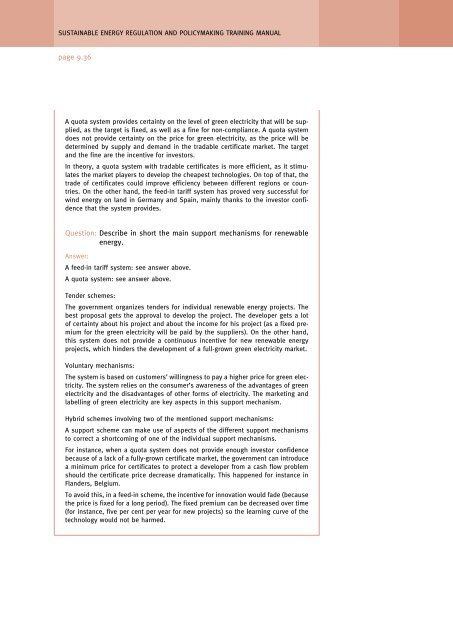Regulatory and policy options to encourage development of ...
Regulatory and policy options to encourage development of ...
Regulatory and policy options to encourage development of ...
- No tags were found...
You also want an ePaper? Increase the reach of your titles
YUMPU automatically turns print PDFs into web optimized ePapers that Google loves.
SUSTAINABLE ENERGY REGULATION AND POLICYMAKING TRAINING MANUALpage 9.36A quota system provides certainty on the level <strong>of</strong> green electricity that will be supplied,as the target is fixed, as well as a fine for non-compliance. A quota systemdoes not provide certainty on the price for green electricity, as the price will bedetermined by supply <strong>and</strong> dem<strong>and</strong> in the tradable certificate market. The target<strong>and</strong> the fine are the incentive for inves<strong>to</strong>rs.In theory, a quota system with tradable certificates is more efficient, as it stimulatesthe market players <strong>to</strong> develop the cheapest technologies. On <strong>to</strong>p <strong>of</strong> that, thetrade <strong>of</strong> certificates could improve efficiency between different regions or countries.On the other h<strong>and</strong>, the feed-in tariff system has proved very successful forwind energy on l<strong>and</strong> in Germany <strong>and</strong> Spain, mainly thanks <strong>to</strong> the inves<strong>to</strong>r confidencethat the system provides.Question: Describe in short the main support mechanisms for renewableenergy.Answer:A feed-in tariff system: see answer above.A quota system: see answer above.Tender schemes:The government organizes tenders for individual renewable energy projects. Thebest proposal gets the approval <strong>to</strong> develop the project. The developer gets a lo<strong>to</strong>f certainty about his project <strong>and</strong> about the income for his project (as a fixed premiumfor the green electricity will be paid by the suppliers). On the other h<strong>and</strong>,this system does not provide a continuous incentive for new renewable energyprojects, which hinders the <strong>development</strong> <strong>of</strong> a full-grown green electricity market.Voluntary mechanisms:The system is based on cus<strong>to</strong>mers’ willingness <strong>to</strong> pay a higher price for green electricity.The system relies on the consumer’s awareness <strong>of</strong> the advantages <strong>of</strong> greenelectricity <strong>and</strong> the disadvantages <strong>of</strong> other forms <strong>of</strong> electricity. The marketing <strong>and</strong>labelling <strong>of</strong> green electricity are key aspects in this support mechanism.Hybrid schemes involving two <strong>of</strong> the mentioned support mechanisms:A support scheme can make use <strong>of</strong> aspects <strong>of</strong> the different support mechanisms<strong>to</strong> correct a shortcoming <strong>of</strong> one <strong>of</strong> the individual support mechanisms.For instance, when a quota system does not provide enough inves<strong>to</strong>r confidencebecause <strong>of</strong> a lack <strong>of</strong> a fully-grown certificate market, the government can introducea minimum price for certificates <strong>to</strong> protect a developer from a cash flow problemshould the certificate price decrease dramatically. This happened for instance inFl<strong>and</strong>ers, Belgium.To avoid this, in a feed-in scheme, the incentive for innovation would fade (becausethe price is fixed for a long period). The fixed premium can be decreased over time(for instance, five per cent per year for new projects) so the learning curve <strong>of</strong> thetechnology would not be harmed.










